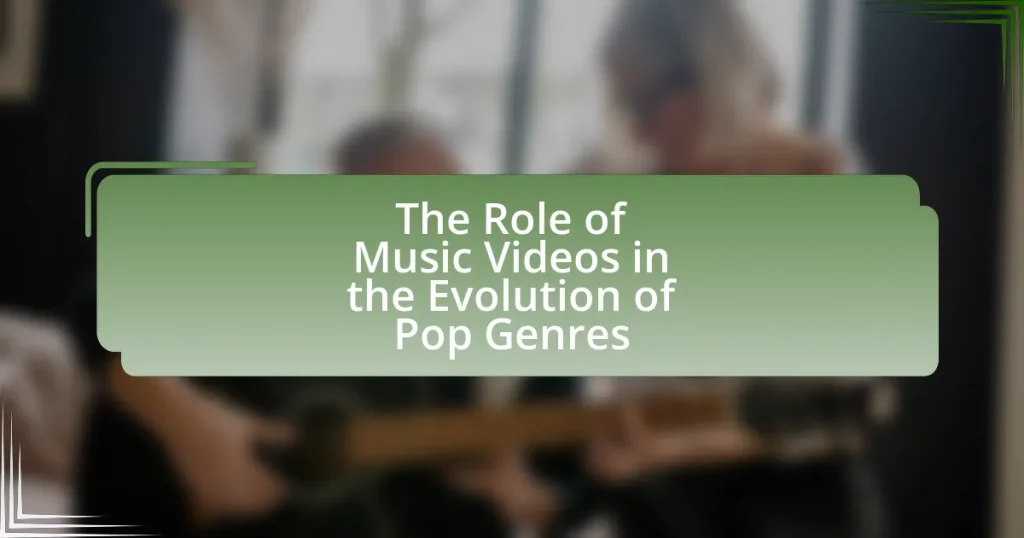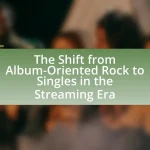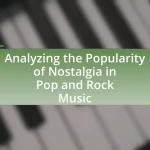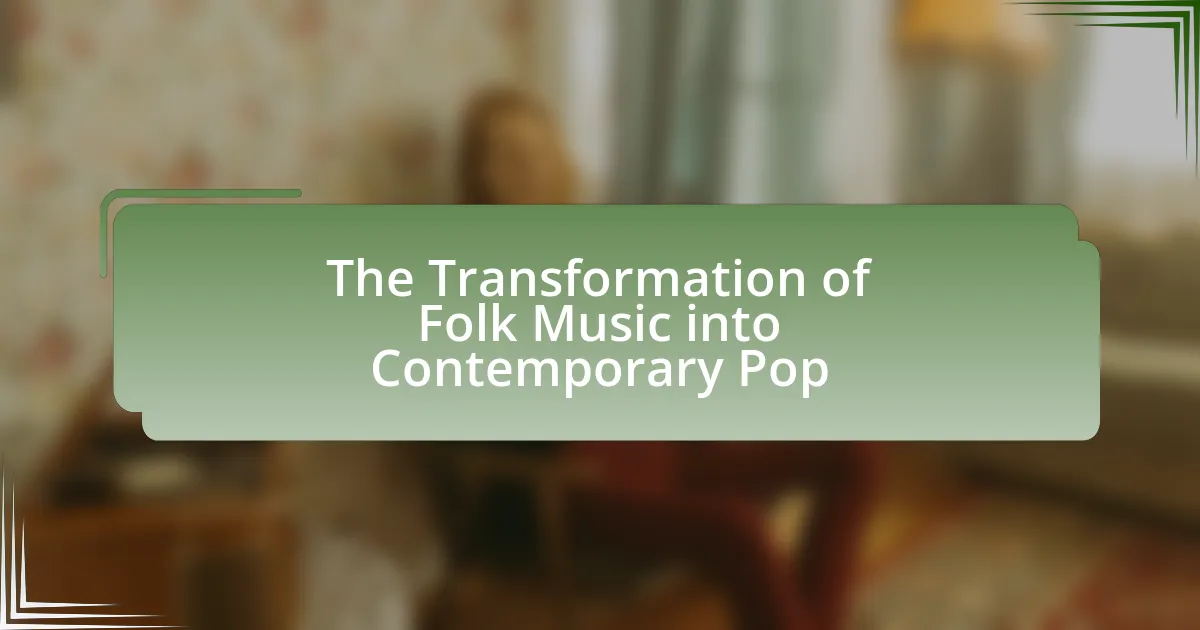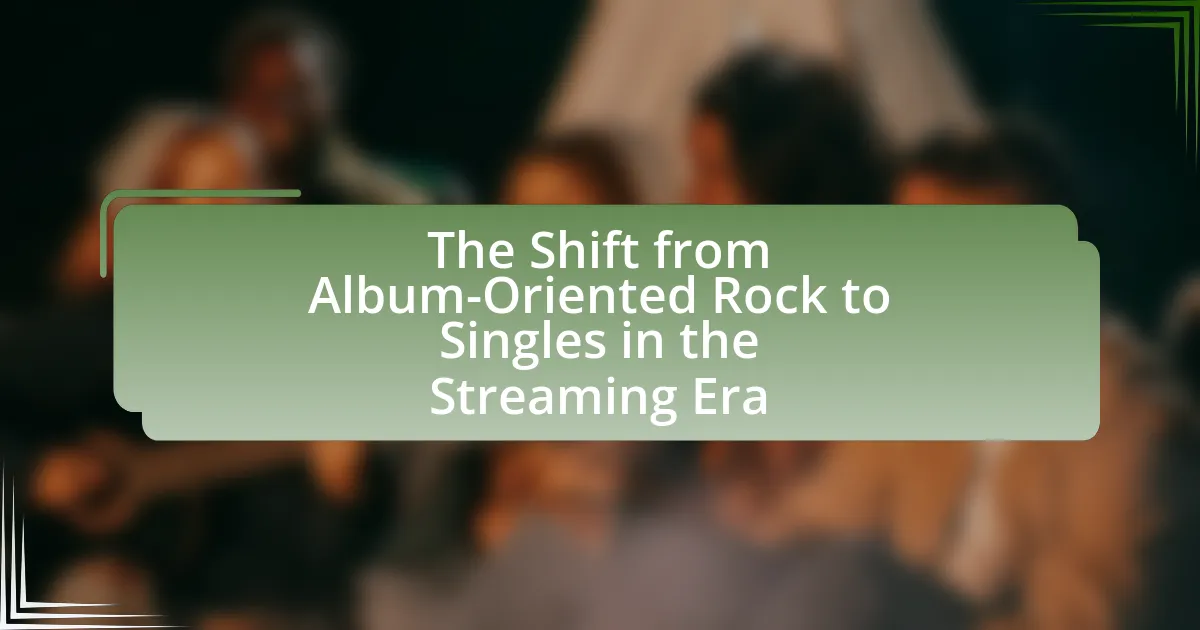The article examines the pivotal role of music videos in the evolution of pop genres, highlighting their function as visual representations that enhance musical appeal and cultural impact. It discusses historical milestones, such as the launch of MTV and the influence of iconic artists like Michael Jackson and Madonna, which transformed music consumption and marketing strategies. The article also explores how music videos reflect changes in pop music styles, contribute to artists’ brand identities, and shape audience perceptions, while addressing the psychological effects on viewers and the impact of technology on production. Additionally, it outlines future trends in music video creation, emphasizing the importance of adapting to evolving audience preferences and the integration of social media platforms.
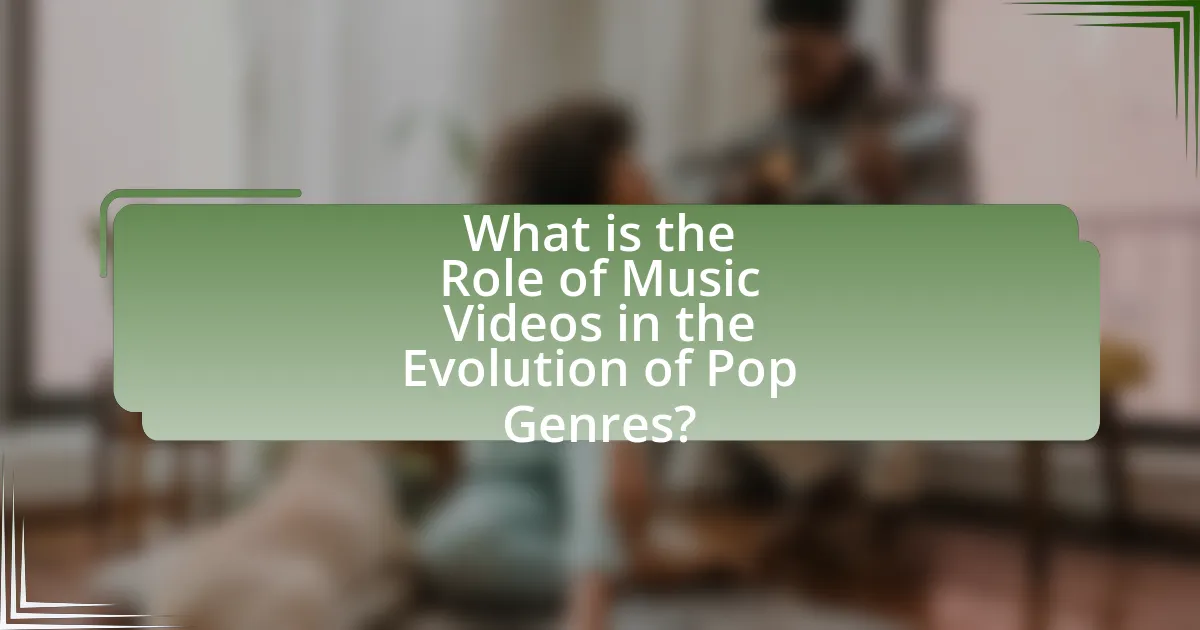
What is the Role of Music Videos in the Evolution of Pop Genres?
Music videos play a crucial role in the evolution of pop genres by serving as a visual representation that enhances the music’s appeal and cultural impact. They have transformed how artists communicate their messages, allowing for storytelling and artistic expression that complements the audio experience. For instance, the rise of MTV in the 1980s revolutionized the music industry, as artists like Michael Jackson and Madonna utilized music videos to define their brands and influence pop culture. This visual medium has also facilitated genre blending, as seen in the incorporation of hip-hop aesthetics into pop videos, which has broadened the audience and reshaped genre boundaries. Furthermore, studies indicate that music videos significantly increase song popularity and streaming numbers, demonstrating their effectiveness in marketing and audience engagement.
How have music videos influenced the development of pop music?
Music videos have significantly influenced the development of pop music by enhancing visual storytelling and expanding the reach of artists. The introduction of MTV in 1981 marked a pivotal moment, as it transformed how music was consumed, making visuals an integral part of the music experience. Artists like Michael Jackson and Madonna utilized music videos to create iconic imagery that complemented their songs, leading to increased sales and popularity. For instance, Jackson’s “Thriller” not only became a cultural phenomenon but also set a standard for production quality and narrative depth in music videos. This visual emphasis has continued to shape pop music, with platforms like YouTube allowing for global distribution and engagement, further solidifying the connection between music and visual art in the genre.
What historical milestones mark the integration of music videos in pop culture?
The integration of music videos in pop culture is marked by several historical milestones, including the release of “Video Killed the Radio Star” by The Buggles in 1981, which was the first music video played on MTV, establishing the platform as a cultural phenomenon. The launch of MTV itself in 1981 revolutionized how music was consumed, making music videos a central aspect of marketing and artist promotion. In 1983, Michael Jackson’s “Thriller” set new standards for production quality and storytelling in music videos, becoming a cultural touchstone and significantly increasing the genre’s popularity. The 1990s saw the rise of artists like Madonna and Nirvana, whose innovative videos further solidified the importance of visual storytelling in music. By the 2000s, platforms like YouTube transformed music video distribution, allowing for global access and interaction, thus embedding music videos deeply into the fabric of pop culture.
How do music videos reflect changes in pop music styles over time?
Music videos reflect changes in pop music styles over time by visually representing the evolving themes, aesthetics, and cultural influences of the genre. For instance, the transition from the vibrant, colorful visuals of the 1980s, exemplified by artists like Madonna, to the darker, more introspective themes in the 1990s, as seen in Nirvana’s “Smells Like Teen Spirit,” illustrates a shift in societal attitudes and musical expression. Additionally, the rise of digital technology in the 2000s led to more innovative and experimental visuals, as seen in Lady Gaga’s “Bad Romance,” which combined fashion, art, and performance to redefine pop music’s visual landscape. This evolution is further evidenced by the increasing integration of social media and streaming platforms, which have transformed how music videos are produced and consumed, reflecting contemporary trends and audience engagement.
Why are music videos considered essential for pop artists?
Music videos are considered essential for pop artists because they serve as a powerful visual marketing tool that enhances audience engagement and promotes brand identity. The integration of visuals with music allows artists to convey their artistic vision, tell stories, and create memorable experiences that resonate with fans. According to a study by the International Journal of Music Business Research, music videos significantly increase song popularity and streaming numbers, with platforms like YouTube being a primary source for music discovery. This visual medium not only amplifies the reach of a song but also helps establish a distinct image for the artist, making it a crucial component of their overall marketing strategy.
What impact do music videos have on an artist’s brand and image?
Music videos significantly enhance an artist’s brand and image by providing a visual representation that complements their music. This visual medium allows artists to express their identity, style, and artistic vision, which can lead to stronger audience connections. For instance, iconic music videos like Michael Jackson’s “Thriller” not only showcased his dance skills but also established him as a cultural icon, influencing fashion and trends. Additionally, research from the Journal of Marketing found that music videos can increase an artist’s visibility and marketability, leading to higher sales and streaming numbers. Thus, music videos play a crucial role in shaping and reinforcing an artist’s public persona and commercial success.
How do music videos contribute to the commercial success of pop songs?
Music videos significantly enhance the commercial success of pop songs by providing a visual narrative that engages audiences and promotes the song across multiple platforms. The combination of audio and visual elements creates a memorable experience, increasing the likelihood of song sharing and streaming. For instance, a study by Nielsen Music found that songs with music videos receive 50% more streams than those without. Additionally, platforms like YouTube serve as a primary discovery tool, with over 2 billion users, allowing music videos to reach vast audiences and drive sales. This visual engagement not only boosts immediate song popularity but also contributes to long-term brand building for artists, as seen with artists like Taylor Swift and Beyoncé, whose music videos often become cultural phenomena, further solidifying their commercial success.
What are the key elements of effective music videos in pop genres?
The key elements of effective music videos in pop genres include strong visual storytelling, engaging choreography, and a clear connection to the song’s themes. Strong visual storytelling captivates the audience and enhances the emotional impact of the music, as seen in videos like Taylor Swift’s “Blank Space,” which uses narrative to complement the lyrics. Engaging choreography is essential, as it not only showcases the artist’s performance skills but also encourages viewer participation, exemplified by the viral dance routines in videos like “Uptown Funk” by Mark Ronson featuring Bruno Mars. A clear connection to the song’s themes ensures that the visuals resonate with the audience, reinforcing the message and mood of the music, as demonstrated in Billie Eilish’s “Bad Guy,” where the visuals reflect the song’s playful yet dark undertones. These elements collectively contribute to the effectiveness of pop music videos, making them memorable and impactful.
How do visual storytelling and aesthetics enhance the music experience?
Visual storytelling and aesthetics significantly enhance the music experience by creating a multi-sensory engagement that deepens emotional connection and understanding of the music. When visuals complement the auditory elements, they provide context and narrative that can amplify the themes and emotions conveyed in the song. For instance, a study by the University of Southern California found that music videos with strong visual narratives can increase viewer retention and emotional response by up to 60%. This synergy between sound and imagery allows audiences to experience music not just as an auditory phenomenon but as a holistic art form, enriching their overall enjoyment and interpretation.
What role does choreography play in the appeal of pop music videos?
Choreography significantly enhances the appeal of pop music videos by creating visually engaging performances that captivate audiences. The synchronization of dance movements with music not only amplifies the emotional impact of the song but also showcases the artist’s talent and charisma. For instance, iconic music videos like Michael Jackson’s “Thriller” and Beyoncé’s “Single Ladies” demonstrate how intricate choreography can become a defining element of a song’s identity, leading to increased viewer retention and cultural relevance. Studies indicate that music videos featuring strong choreography often achieve higher view counts and social media engagement, underscoring the importance of dance in attracting and maintaining audience interest.
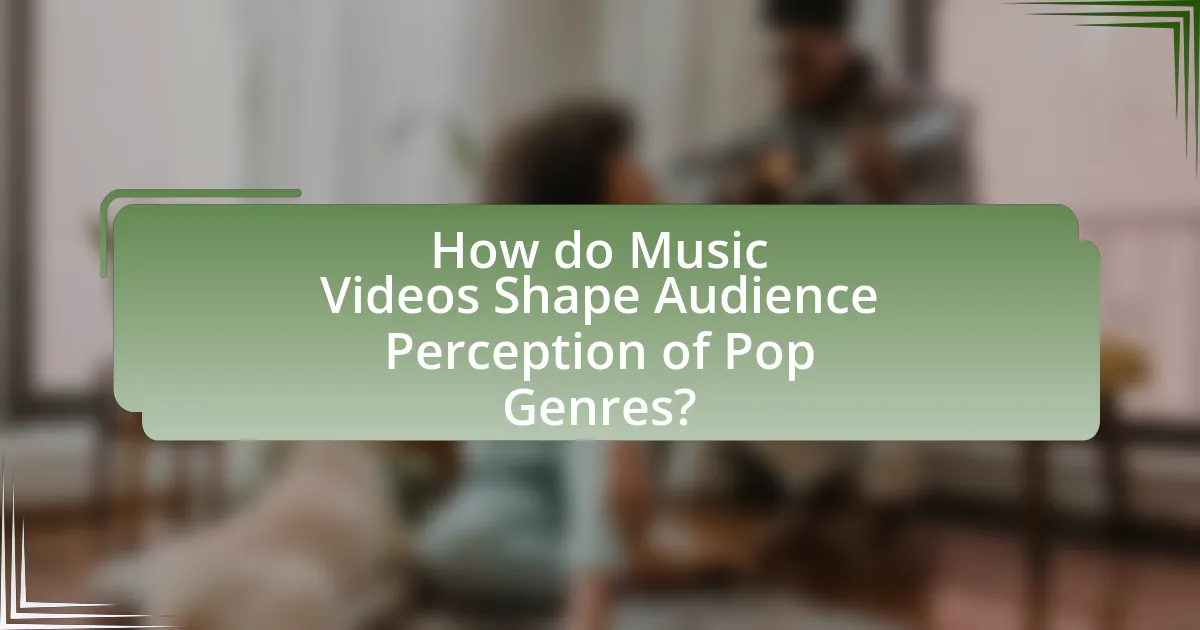
How do Music Videos Shape Audience Perception of Pop Genres?
Music videos significantly shape audience perception of pop genres by visually reinforcing the themes, styles, and cultural contexts associated with the music. They serve as a powerful medium for artists to convey their artistic identity and connect emotionally with viewers, influencing how audiences interpret the music. For instance, a study by the University of Southern California found that music videos can enhance the emotional response to songs, making the music more memorable and impactful. Additionally, the visual elements in music videos often reflect current trends and societal issues, further aligning the genre with contemporary cultural narratives. This interplay between visuals and music helps to establish genre conventions and can even redefine audience expectations, as seen in the evolution of pop from the 1980s to the present, where music videos have played a crucial role in shaping the genre’s identity.
What psychological effects do music videos have on viewers?
Music videos significantly influence viewers’ psychological states by evoking emotions, shaping perceptions, and reinforcing social norms. Research indicates that music videos can enhance mood and increase feelings of happiness or sadness, depending on the content and themes presented. For instance, a study published in the Journal of Broadcasting & Electronic Media found that viewers often experience heightened emotional responses to music videos that align with their personal experiences or emotional states. Additionally, music videos can impact viewers’ self-image and body perception, as they often portray idealized lifestyles and appearances, leading to potential issues such as body dissatisfaction. This effect is supported by findings from the International Journal of Eating Disorders, which highlight a correlation between exposure to music videos and negative body image among adolescents. Overall, music videos serve as powerful tools that can shape emotional responses and influence social attitudes among viewers.
How do music videos create emotional connections with audiences?
Music videos create emotional connections with audiences by visually interpreting the themes and emotions of the accompanying songs. This visual representation enhances the storytelling aspect of the music, allowing viewers to engage with the narrative on a deeper level. For instance, a study published in the Journal of Media Psychology found that music videos that align closely with the emotional tone of the song significantly increase viewer empathy and emotional response. By using imagery, color, and symbolism, music videos evoke feelings that resonate with personal experiences, making the music more relatable and impactful.
What role does imagery play in shaping genre identity through music videos?
Imagery plays a crucial role in shaping genre identity through music videos by visually reinforcing the themes, aesthetics, and cultural contexts associated with specific music genres. For instance, hip-hop music videos often feature urban landscapes, street fashion, and symbols of wealth, which align with the genre’s roots in urban culture and self-expression. Similarly, country music videos frequently depict rural settings, traditional attire, and narratives of love and heartbreak, reflecting the genre’s storytelling tradition. This visual representation not only enhances audience engagement but also solidifies genre boundaries by creating recognizable visual cues that audiences associate with particular styles of music. Research indicates that these visual elements significantly influence audience perceptions and expectations, thereby contributing to the overall identity of the genre.
How do music videos contribute to the popularity of specific pop subgenres?
Music videos significantly enhance the popularity of specific pop subgenres by visually representing the music and creating a distinct aesthetic that resonates with audiences. For instance, the rise of hip-hop in the 1990s was bolstered by music videos that showcased urban culture, fashion, and lifestyle, making the genre more relatable and appealing to a broader audience. Additionally, platforms like MTV and YouTube have played crucial roles in promoting these videos, allowing for viral trends that can propel a subgenre into mainstream success. The visual storytelling in music videos often amplifies the themes and emotions of the songs, making them more memorable and shareable, which in turn increases their reach and popularity.
What trends in music video production have emerged with different pop subgenres?
Trends in music video production have evolved significantly across various pop subgenres, reflecting their unique aesthetics and cultural influences. For instance, the rise of hyper-realistic visuals and elaborate storytelling is prominent in K-pop, where videos often feature high production values, intricate choreography, and vibrant color palettes, as seen in BTS and BLACKPINK’s works. In contrast, indie pop videos frequently embrace a more DIY aesthetic, utilizing lo-fi visuals and narrative-driven content to convey authenticity, exemplified by artists like Billie Eilish. Additionally, the integration of social media platforms has led to shorter, more engaging clips that cater to viral trends, particularly in the case of TikTok-driven pop, where artists like Doja Cat leverage quick, catchy visuals to enhance audience engagement. These trends illustrate how music video production adapts to the characteristics of each subgenre while also responding to technological advancements and audience preferences.
How do collaborations in music videos influence genre blending?
Collaborations in music videos significantly influence genre blending by merging distinct musical styles and cultural elements, creating innovative sounds that appeal to diverse audiences. For instance, the collaboration between Lil Nas X and Billy Ray Cyrus on “Old Town Road” combined country and hip-hop, leading to a viral sensation that redefined genre boundaries. This blending is further evidenced by the rise of artists like Post Malone, who seamlessly integrates rock, hip-hop, and pop in his music videos, showcasing the fluidity of genres. Such collaborations not only enhance the visibility of different genres but also encourage artists to experiment, resulting in a richer musical landscape.
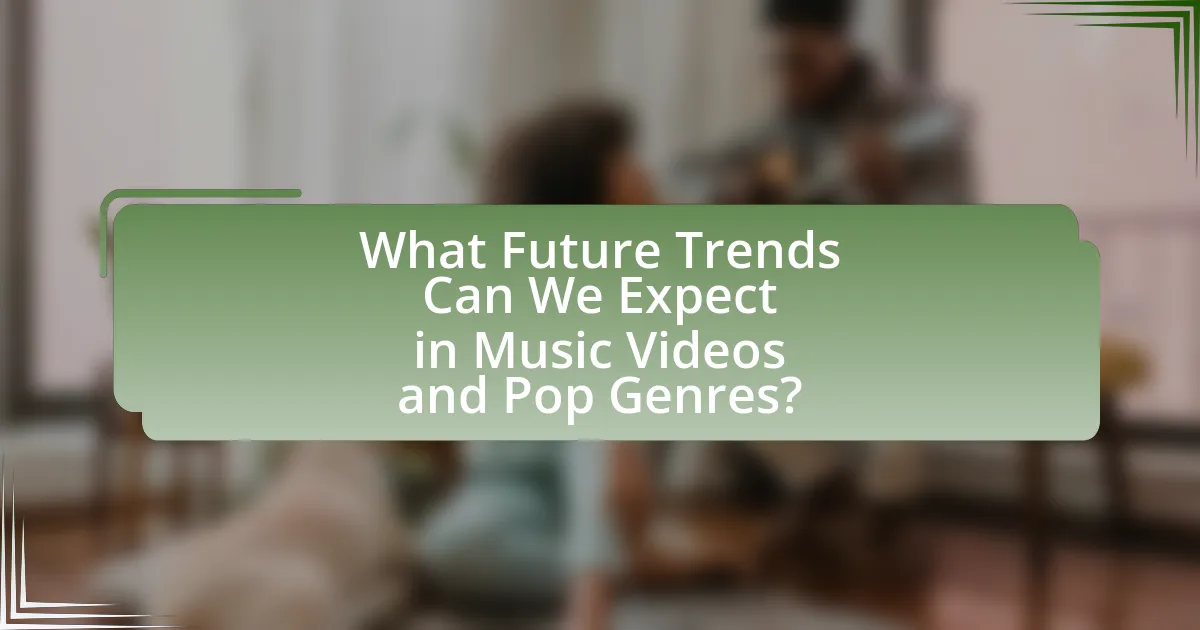
What Future Trends Can We Expect in Music Videos and Pop Genres?
Future trends in music videos and pop genres will likely include increased integration of augmented reality (AR) and virtual reality (VR) technologies, allowing for immersive viewer experiences. As artists seek to engage audiences more deeply, platforms like TikTok and Instagram will continue to influence the format and style of music videos, emphasizing shorter, more dynamic content that caters to mobile consumption. Additionally, data-driven personalization will shape how music videos are created and distributed, with algorithms tailoring content to individual viewer preferences. This shift is supported by the rise of streaming services, which have reported that personalized playlists and recommendations significantly enhance user engagement.
How is technology changing the landscape of music video production?
Technology is transforming music video production by enabling higher quality visuals, innovative storytelling techniques, and greater accessibility for creators. Advances in camera technology, such as 4K and 8K resolution, allow for stunning imagery that enhances viewer engagement. Additionally, software for editing and visual effects, like Adobe Premiere Pro and After Effects, empowers creators to produce professional-grade videos with relative ease. The rise of platforms like YouTube and TikTok democratizes distribution, allowing independent artists to reach global audiences without traditional gatekeepers. According to a report by Statista, as of 2021, YouTube had over 2 billion logged-in monthly users, illustrating the vast potential for music videos to gain exposure.
What innovations in virtual reality and augmented reality are being used in music videos?
Innovations in virtual reality (VR) and augmented reality (AR) being used in music videos include immersive 360-degree experiences and interactive elements that engage viewers. For instance, artists like Travis Scott have utilized VR to create fully immersive environments in their music videos, allowing fans to explore virtual worlds that complement the music. Additionally, AR technology has been employed in videos such as those by Billie Eilish, where digital effects overlay real-world footage, enhancing the visual storytelling. These innovations not only elevate the viewer’s experience but also create new avenues for artistic expression and audience interaction, as evidenced by the increasing integration of VR and AR in major music releases.
How do social media platforms influence the distribution and style of music videos?
Social media platforms significantly influence the distribution and style of music videos by providing artists with direct access to audiences and enabling viral sharing. These platforms, such as YouTube, Instagram, and TikTok, allow musicians to release their videos independently, bypassing traditional media channels, which increases their reach and visibility. For instance, TikTok’s short-form video format encourages creative and concise storytelling, leading to a rise in music videos that are visually engaging and designed for quick consumption. Additionally, data from a 2021 report by the International Federation of the Phonographic Industry indicates that 80% of music consumers discover new music through social media, highlighting its role in shaping music trends and styles. This direct interaction fosters a feedback loop where artists can adapt their content based on audience reactions, further influencing the evolution of music video aesthetics and themes.
What are the implications of changing viewer habits on music video creation?
Changing viewer habits significantly impact music video creation by necessitating shorter, more engaging content tailored for platforms like TikTok and Instagram. As audiences increasingly favor bite-sized videos over traditional long-form content, creators adapt by focusing on quick storytelling and visually captivating elements to retain viewer attention. For instance, a study by Nielsen in 2021 indicated that 67% of consumers prefer videos under 60 seconds, prompting artists to innovate their approaches to align with these preferences. Consequently, music videos are evolving to prioritize immediate visual impact and shareability, reflecting the shift in how audiences consume media.
How do streaming services affect the traditional music video model?
Streaming services significantly alter the traditional music video model by prioritizing accessibility and viewer engagement over broadcast limitations. Unlike traditional music videos that relied on television airplay and scheduled programming, streaming platforms allow users to watch videos on-demand, leading to increased viewer control and interaction. This shift has resulted in a decline in the importance of narrative-driven music videos, as artists now focus on creating visually captivating content that can quickly capture attention in a crowded digital landscape. According to a report by Nielsen, music video consumption on platforms like YouTube has surged, with billions of views per day, demonstrating the shift in how audiences engage with music videos compared to traditional formats.
What strategies can artists use to adapt to evolving audience preferences in music videos?
Artists can adapt to evolving audience preferences in music videos by leveraging data analytics, engaging with social media trends, and collaborating with diverse creators. Data analytics allows artists to understand viewer demographics and preferences, enabling them to tailor content that resonates with their audience. For instance, platforms like YouTube provide insights into viewer behavior, helping artists identify popular themes and styles. Engaging with social media trends, such as viral challenges or popular aesthetics, allows artists to create relevant content that captures audience attention. Collaborating with diverse creators can also introduce fresh perspectives and broaden appeal, as seen in successful partnerships that merge different genres and styles, attracting wider audiences. These strategies are supported by the increasing importance of digital platforms in shaping music consumption habits, where adaptability is crucial for maintaining relevance.
What best practices should artists follow when creating music videos for pop genres?
Artists should prioritize storytelling, visual aesthetics, and audience engagement when creating music videos for pop genres. Storytelling enhances emotional connection, making the video memorable; for instance, narrative-driven videos often resonate more with viewers, as seen in Taylor Swift’s “Blank Space,” which tells a clear story. Visual aesthetics, including vibrant colors and dynamic camera work, are crucial in pop music videos to capture attention quickly; studies show that visually appealing content increases viewer retention. Lastly, engaging the audience through interactive elements or relatable themes fosters a sense of community and encourages sharing, which is vital for viral success in pop music.
